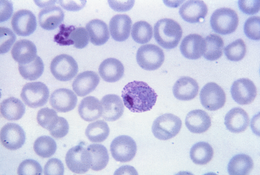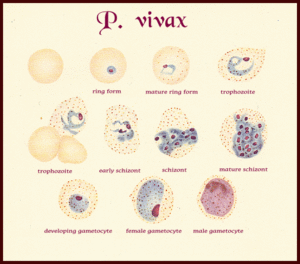Plasmodium vivax
Classification
Domain: Eukaryote
Phylum: Apicomplexa
Class: Aconoidasida
Order: Haemosporida
family: Plasmodiidae
Species
|
NCBI: Taxonomy |
Plasmodium vivax
Description and Significance
Describe the appearance, habitat, etc. of the organism, and why you think it is important.
Appearance
P. vivax are parasites found inhabiting the liver and blood at various stages of development and shape. Starting as rings within red blood cells, then trophozoites as they develop within the red blood cells. Next, they form round gametocytes filling the red blood cells and schizonts which are elongated and wormlike, further filling out the red blood cells. Red blood cells infected by P. vivax cause swelling of the cell, increasing the size by approximately 1.5 times the size.
Habitat
P. vivax is found within South America and Asia, along with smaller amounts found within Africa along the horn and Madagascar.
Signifigacne
Genome Structure
Describe the size and content of the genome. How many chromosomes? Circular or linear? Other interesting features? What is known about its sequence?
Cell Structure, Metabolism and Life Cycle
Metablism
Life Cycle / Cell Structure
Plasmodium genus eukaryotes form a typical lifecycle characterized by infection from insect host to vertebrate host. P. vivax first enters a vertebrate host through injection by Anopheles mosquitoes (female only) where P. vivax makes their way from the blood to the liver, entering hepatic cells and undergoing replication before exiting to infect erythrocytes and forming hypnozoites and merozoites, some differing to form gametocytes to be picked up by other mosquitoes to continue the cycle.
Human Infection
Liver Stage
Erythrocytic Stage
Mosquito Infection
Fertilization
Sporogony
Ecology and Pathogenesis
Habitat; symbiosis; biogeochemical significance; contributions to environment.
If relevant, how does this organism cause disease? Human, animal, plant hosts? Virulence factors, as well as patient symptoms.
Symbiosis
Symptoms
References
[a] Vogel G. The forgotten malaria. Science. 2013;342(6159):684‐687. doi:10.1126/science.342.6159.684
Author
Page authored by Jonathan Ward, student of Prof. Jay Lennon at IndianaUniversity.


